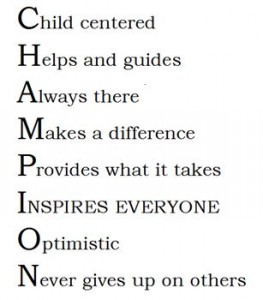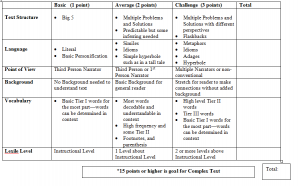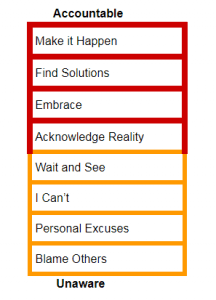Champion. A personal note to my school.
I wrote this blog in 2016 and never thought I could admire my TES family more—but I do! This flashback blog is dedicated to TES and EAST in Alexander County. Your determination, intense passion, and dedication are second to none. I am so proud of the way you put children first.
What is a champion?
I re-watched the video of Rita Pierson, which I highly recommend. (Available on Ted Talks: https://www.ted.com/talks/rita_pierson_every_kid_needs_a_champion?language=en). I thought back to champions in my own life and (of course) looked the word up to dissect the meaning. As you would expect, among the definition and synonyms, I found the term winner, superstar, first place, etc. But, I also found words such as support and advocate. As all these thoughts swirled in my mind, some words a colleague shared with me this week began to take form in my mind, dutiful and compliant.
Think about all these words together…
Is a champion being simply good or the best at something? Does it mean having the highest test scores or making the most growth? Does it mean being the top ranked school in the county? Maybe. Could it also mean—having a great relationship with colleagues and children? Could it mean being respected and trusted by others? Could it mean doing your job to the best of your ability and being the BEST person and educator YOU can be?
As a history buff, I have read about many champions in our history including Galileo, Socrates, Mother Teresa, Martin Luther King Jr., and any of our founding fathers. Everyday people are champions such as Rosa Parks or Todd Beamer and the people on Flight 93 who stood up to terrorists to save others. But does it have to be that EXTREME?
At my school, I watch champions every day. Here is what the term CHAMPION means to me and the everyday acts that help to define the term.
A CHAMPION is a person who …
- dutifully gives assessments to students with a smile and kind heart. They tirelessly repeat the same directions in a positive manner to make each student feel like they are attaining something that no other student has for their teacher.
- greets each student with their name, a smile, a hug each day (even when they are dealing with struggles of their own). These small acts create positive relationships that endure.
- gives a student structure and discipline paired with compassion and love.
- makes sacrifices for their students or colleagues without question and without complaint, even something small such as switching schedules or assistants. Even bigger sacrifices such as providing for a child’s needs (fieldtrips, glasses, lunches, etc.) or attending outside events such as ballgames, birthday parties, etc.
- has a flexible mind set and is willing to go the extra mile to get the job done no matter what it is such as covering for testing, doing without help so another class or teacher can be covered or simply having to clean up or do something that is not your job.
- gives support to their colleagues and respond to their needs such as a meal, a treat, a hug, a smile and most of all a confidential place to talk.
- advocates and speaks for those who need a voice.
- provides after school tutoring or sometimes “intervention” both of which have an important place
Everyday champions are in our midst and the reason this is important is within this quote:
It is not light that we need, but fire; it is not the gentle shower, but thunder. We need the storm, the whirlwind, and the earthquake.
——-Frederick Douglass
In our lives we are faced with storms and how we respond to these storms are different. Some people choose to stay dutiful and stay the course while others try to change the course of the winds. All of us, no matter how we choose to battle the storm, want to weather the storm in the end. Champions can be the wild winds that veer the course of the storm but can also be those calm winds that settle in between.
When we as a school must deal with a storm, may we remember that we will all deal with this storm differently but we all want the best outcome. Do not allow our differences to divide us but to bring us together and remember that together —-WE ARE collective CHAMPIONS.



 Roger Connors’ ideas from the Oz Principle:
Roger Connors’ ideas from the Oz Principle: